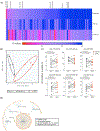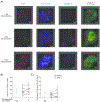Luminal microvesicles uniquely influence translocating bacteria after SIV infection
- PMID: 33731830
- PMCID: PMC8225551
- DOI: 10.1038/s41385-021-00393-8
Luminal microvesicles uniquely influence translocating bacteria after SIV infection
Abstract
Microbial translocation contributes to persistent inflammation in both treated and untreated HIV infection. Although translocation is due in part to a disintegration of the intestinal epithelial barrier, there is a bias towards the translocation of Proteobacteria. We hypothesized that intestinal epithelial microvesicle cargo differs after HIV infection and contributes to biased translocation. We isolated gastrointestinal luminal microvesicles before and after progressive simian immunodeficiency virus (SIV) infection in rhesus macaques and measured miRNA and antimicrobial peptide content. We demonstrate that these microvesicles display decreased miR-28-5p, -484, -584-3p, and -584-5p, and let-7b-3p, as well as increased beta-defensin 1 after SIV infection. We further observed dose-dependent growth sensitivity of commensal Lactobacillus salivarius upon co-culture with isolated microvesicles. Infection-associated microvesicle differences were not mirrored in non-progressively SIV-infected sooty mangabeys. Our findings describe novel alterations of antimicrobial control after progressive SIV infection that influence the growth of translocating bacterial taxa. These studies may lead to the development of novel therapeutics for treating chronic HIV infection, microbial translocation, and inflammation.
Conflict of interest statement
DISCLOSURES
The authors have no conflicts of interest to declare.
Figures






Similar articles
-
Walk on the wild side: SIV infection in African non-human primate hosts-from the field to the laboratory.Front Immunol. 2023 Jan 12;13:1060985. doi: 10.3389/fimmu.2022.1060985. eCollection 2022. Front Immunol. 2023. PMID: 36713371 Free PMC article. Review.
-
Longitudinal Examination of the Intestinal Lamina Propria Cellular Compartment of Simian Immunodeficiency Virus-Infected Rhesus Macaques Provides Broader and Deeper Insights into the Link between Aberrant MicroRNA Expression and Persistent Immune Activation.J Virol. 2016 Apr 29;90(10):5003-5019. doi: 10.1128/JVI.00189-16. Print 2016 May 15. J Virol. 2016. PMID: 26937033 Free PMC article.
-
Gut Microbiome Changes Associated with Epithelial Barrier Damage and Systemic Inflammation during Antiretroviral Therapy of Chronic SIV Infection.Viruses. 2021 Aug 8;13(8):1567. doi: 10.3390/v13081567. Viruses. 2021. PMID: 34452432 Free PMC article.
-
Dysbiotic bacteria translocate in progressive SIV infection.Mucosal Immunol. 2015 Sep;8(5):1009-20. doi: 10.1038/mi.2014.128. Epub 2015 Jan 14. Mucosal Immunol. 2015. PMID: 25586559 Free PMC article.
-
The Hitchhiker Guide to CD4+ T-Cell Depletion in Lentiviral Infection. A Critical Review of the Dynamics of the CD4+ T Cells in SIV and HIV Infection.Front Immunol. 2021 Jul 21;12:695674. doi: 10.3389/fimmu.2021.695674. eCollection 2021. Front Immunol. 2021. PMID: 34367156 Free PMC article.
Cited by
-
Butyrate administration is not sufficient to improve immune reconstitution in antiretroviral-treated SIV-infected macaques.Sci Rep. 2022 May 6;12(1):7491. doi: 10.1038/s41598-022-11122-x. Sci Rep. 2022. PMID: 35523797 Free PMC article.
-
Walk on the wild side: SIV infection in African non-human primate hosts-from the field to the laboratory.Front Immunol. 2023 Jan 12;13:1060985. doi: 10.3389/fimmu.2022.1060985. eCollection 2022. Front Immunol. 2023. PMID: 36713371 Free PMC article. Review.
-
Host Genetics and Environment Shape the Composition of the Gastrointestinal Microbiome in Nonhuman Primates.Microbiol Spectr. 2023 Feb 14;11(1):e0213922. doi: 10.1128/spectrum.02139-22. Epub 2022 Dec 8. Microbiol Spectr. 2023. PMID: 36475838 Free PMC article.
References
Publication types
MeSH terms
Substances
Grants and funding
LinkOut - more resources
Full Text Sources
Other Literature Sources

